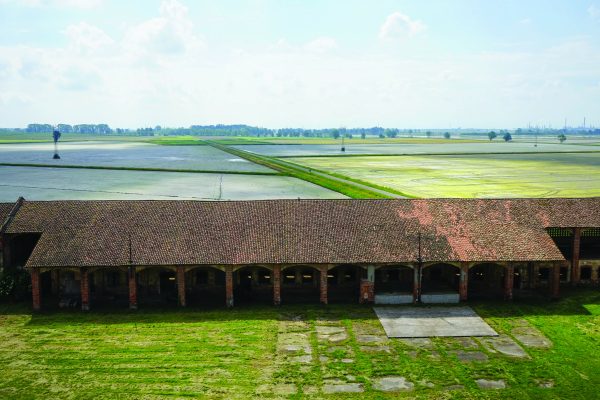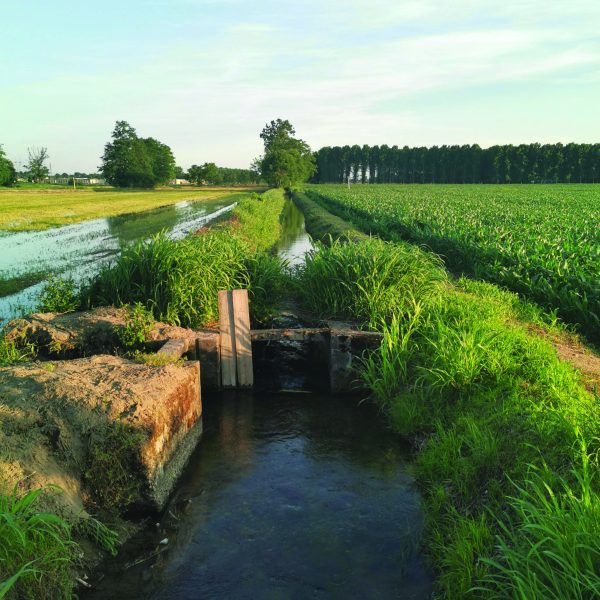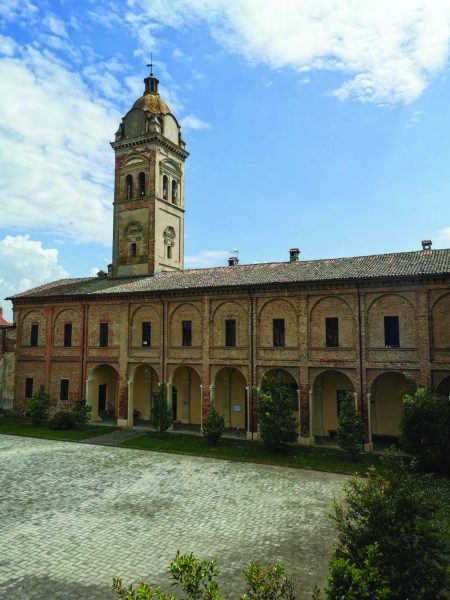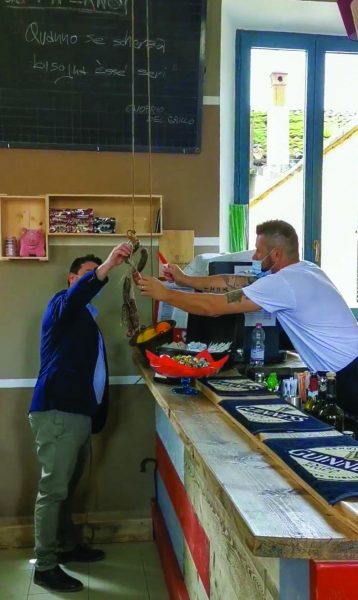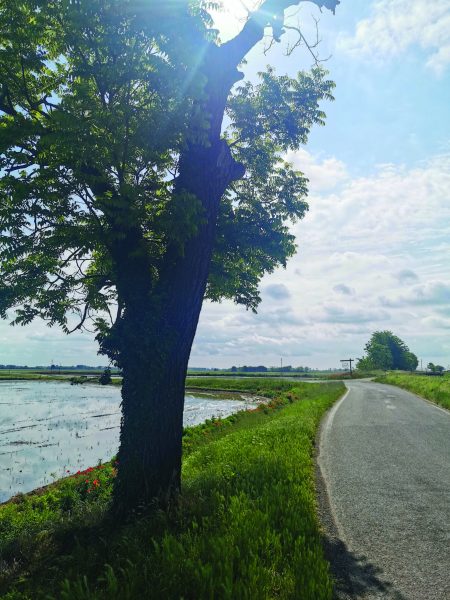Val Nicastro explores this quiet corner of Lombardy known as ‘the Little Loire’ for its picturesque castles in a rural landscape and its traditional village life – and its great local produce
Images by Val Nicastro
The Lomellina region is an unspoiled little pocket of rural southwestern Lombardy, between Milan and Alessandria, stretching towards the Po River, which marks the border with Piedmont. As well as being the southwestern extreme of Lombardy, it is also towards the northwestern extreme of the Po Valley, that vast plain that extends from here to the Adriatic Sea and is known as the bread basket of Italy. As such, Lomellina is a region devoted to agriculture, where farmsteads and green oases share space with noble castles and ancient abbeys, rustic restaurants serve farm-fresh food, and locals are proud guardians of the secrets and traditions behind one of Italy’s most popular dishes, risotto.
1. Welcome to a land of water
The agricultural landscape of the Lomellina region is marked by a complex network of waterways developed through the centuries to irrigate fields and rice paddies. This has resulted in a fascinating mosaic of land and water that gives its best in spring when the flooded rice fields beautifully reflect the surrounding landscape.
Rice cultivation was introduced by Galeazzo Maria Sforza in the 15th century, and has shaped the history and territory of Lomellina, which today, together with Vercelli and Novara, forms Italy’s “golden triangle of rice” and produces a number of high-quality varieties. I would suggest visiting the Isimbardi Castle in Castello d’Agogna, where an exhibition of maps and drawings illustrates the transformation of the territory through the centuries.
This abundance of water has also created the ideal environment for the development of garzaie, the protected sites where herons and numerous other bird species nest, making Lomellina a great destination for birdwatching. One of the most important is the Garzaia di Celpenchio, which is considered a natural monument in Lombardy.
2. A secret spot one hour from Milan
Steeped in history, filled with natural marvels, and wonderfully off the beaten path, the Lomellina region is a place of pristine beauty that offers a real opportunity to experience Italy in the most authentic way. Its position just a stone’s throw from Milan makes it an ideal escape from the city. You’ll find yourself immersed in a microcosm of Italian village life, where tractors and historic farmhouses are a common sight, conversations at the bar are carried out in local dialect, and unexpected treasures reveal deep layers of history.
3. Traditional festivals and food fairs
Lomellina preserves age-old traditions which find expression in the unique events and historical re-enactments that animate its villages. The Palio of Mortara in September is one of the key events of the year and sees the town’s seven contrade compete in a ‘game of the goose’. The re-enactment of the legendary wedding between Theodelinda and Agilulf attracts crowds to Lomello in June, while in August Robbio becomes the stage of the Palio dl’Urmon, with a week-long schedule of games culminating in a final race where participants have to push a heavy handcart loaded with sand. The Lomellina region also has a packed schedule of sagre dedicated to local specialities – from goose salami in Mortara (September) and red onions in Breme (June) to borlotto beans in Gambolò (July) and offelle biscuits in Parona (October).
4. Follow the tracks of ancient pilgrims
The Lombard stretch of the ancient Via Francigena winds its way mostly through the peaceful countryside of Lomellina, where modern-day walkers can retrace the itinerary that Archbishop Sigeric described in his travel journal in the year 990. The Church of San Valeriano in Robbio was an important centre for imperial and papal envoys, while the Abbey of Sant’Albino on the outskirts of Mortara was a major stopover for pilgrims. This was built on the site where Charlemagne’s armies defeated the Lombards of King Desiderius in 773 and continues to offer shelter to pilgrims walking the Via Francigena. Inside, you will find frescoes dating from the 15th century and inscriptions left by the pilgrims on the bricks, the oldest of which dates to 1100.
5. Jewels of Romanesque architecture
The Lomellina region boasts numerous examples of Romanesque architecture that represent a valuable resource for students of local history. Lomello is home to a splendid complex comprising the Baptistery of San Giovanni ad Fontes and the Church of Santa Maria Maggiore. Hidden among rice fields and rows of poplars, the Pieve di Velezzo is one of the oldest Christian centres in the area, while the Abbey of San Pietro in Breme was founded in the 10th century by monks seeking refuge from the Saracen attacks. A number of precious Romanesque treasures can also be found in Robbio, including the small Church of St Peter, decorated with beautiful frescoes known as the “Bible of the poor”, as they were used to educate illiterate people in the teachings of Christianity.
6. Unadulterated village life
There are many villages and hamlets in the Lomellina region that charm with their simplicity and astonish with their history. Forget souvenir stores and high-street brands, in Lomellina it’s all about genuinely local shops, age-old traditions, and the classic café where locals gather to comment on the latest news over coffee. Lomello is the village that gave its name to this area and was a prosperous centre under the Romans and the Lombards. It’s here that the Lombard queen Theodelinda married her second husband, Agilulf, in 590. Mortara is one of Lomellina’s main commercial hubs and two cannonballs on the bell tower of its Basilica of San Lorenzo remind us that the town was a battleground during the Italian wars of independence. Near the border with Piedmont, at the hamlet of Rosasco, traces typical of medieval fortified villages are still visible.
7. Risotto and goose salami
Lomellina gastronomy is firmly rooted in la cucina povera (the cooking of the poor) and makes extensive use of locally grown produce that brings out all the natural flavours of the territory. Being the land of rice, risotto is Lomellina’s signature dish, but the area is also famous for its goose salami. This is a speciality of Mortara and its history goes back to the 15th century when the Duke of Milan Ludovico il Moro authorised the settlement of a Jewish community in the area and goose-based products started to appear to abide by the Kashrut rules. Each village has its own special products. Gambolò, for example, is the place to go for borlotti beans, while Cilavegna produces excellent white asparagus, and Dorno grows pumpkins and saffron. Another star of the local cuisine is Breme’s sweet red-skinned onion, a slow food presidium whose seeds are conserved in the Global Seed Vault on the Svalbard Islands. Wine enthusiasts should go to Agriturismo Pescarolo in Robbio, where two ancient wine varieties, Moradella and Vespolina, have been recovered using the technique adopted by the Celts centuries ago.
8. A great place for cycling
Lomellina’s quiet country roads are perfect for cycling, with a range of dedicated trails immersed in pristine nature. One of these is the Via delle Gallie, the ancient road that the Romans built to connect the Po Valley to France and Switzerland. The local section has been recently refurbished and takes visitors on a 20km journey from Dorno to Lomello, amid rice paddies, cornfields, streams and villages. In Breme, the energetic mayor came up with the idea of a service called “I lend you a bicycle”, which gives tourists free access to bikes to explore the natural surroundings, while Rosasco offers four cycle-pedestrian trails equipped with QR codes to download useful multimedia content and GPX tracks on your mobile devices.
9. Lombardy’s ‘Little Loire’
Lomelllina is dotted with castles and fortifications erected through the centuries to control the territory but also as country residences and hunting lodges. Today, they represent a distinctive feature of the Lomellina landscape, so much so that the area is nicknamed ‘Lombardy’s Little Loire’. There are 26 to explore, each with its own story to tell. There’s the Castle of Sartirana, the largest construction in the area, whose massive cylindrical tower is the work of Ridolfo Fioravanti, the architect who took part in the construction of the Kremlin. The majestic Castle of Valeggio has an unusual trapezoidal structure with seven towers of different shapes and sizes and used to host the hunting expeditions of princes and noblemen, while the Castle of Cozzo once welcomed the king of France Louis XII on his way to claim the Duchy of Milan in 1499.
10. Museum pieces
The local museum system comprises a group of interesting exhibitions housed inside beautiful castles and farmhouses. The best places to start your exploration are the Archeological Museums in Vigevano and Gambolò, which reveal the history of the territory from the Stone Age to the Celts and Romans. The rural heritage of the Lomellina region is on display at the Museum of Farming Art and Tradition in Olevano and the Farmers’ Museum in Frascarolo, both showcasing old agricultural tools and equipment that provide information about work on the farms in the past. For something different, head to the Pila of Sartirana.
Enjoyed this article? Check out our Lombardy archive.

